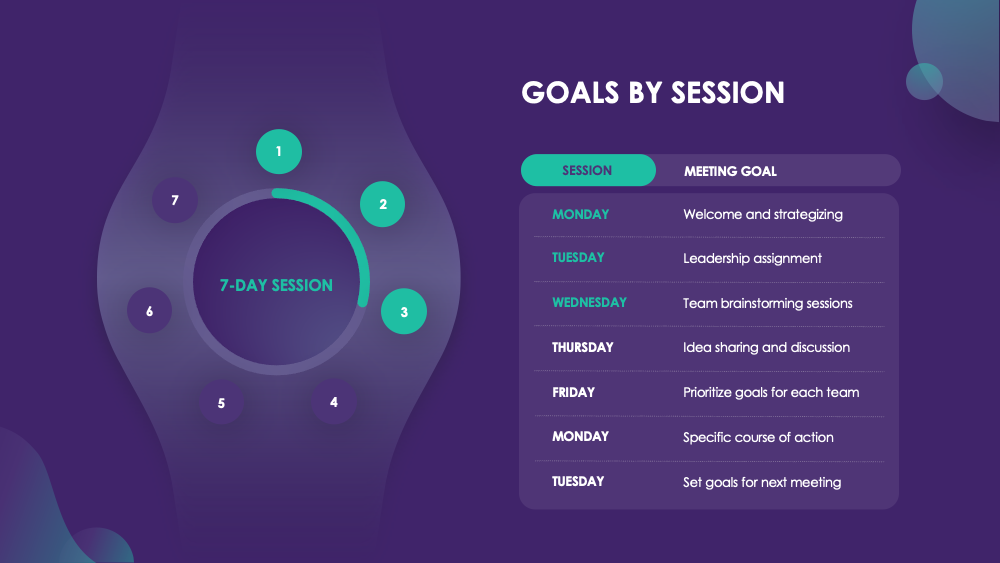Synopsis
As soon as one or two attendees "dial in" to a virtual meeting, productivity starts to suffer, because attendees often interpret virtual meetings as a license to multi-task, "Harvard Business Review" reports. Now that remote work is the new norm, it's especially important to run effective and proactive meetings. Communicate this to your team with our Virtual Meetings deck. To make the task easier for you, we added simple rules and technical instructions to the slides.
Slide highlights
With this slide, share the basic ground rules for all virtual meetings held at your company, such as muting mics when the team members are not speaking, having video on or off (depending on your company policy), etc.
For your convenience, we adjusted fonts to be larger than our usual font sizes. Considering that your audience will now be viewing these on a desktop or laptop instead of a full-size projector, this should improve the experience.
Let your team know that they should always send (and receive) a meeting agenda in advance. This way, everybody has a better sense of control and enough time to better prepare for the meeting and actively participate.
Overview
As our homes and workplaces are merging together, the borderlines between our personal and professional lives are blurring too. That is why it is crucial to follow virtual meetings etiquette. A business communication platform, Slack, provides the following guidelines for remote meetings protocol:
- Introduce everyone during the meeting, and give everyone a chance to contribute
- Don't stare at your phone while other people are presenting
- Don't interrupt other people when they're speaking (or attempt to speak over them)
- Test all technology (including camera/video, Wi-Fi, and screen sharing) before the meeting
- Read the agenda, and come prepared
- Don't work on other tasks (like checking email) during the virtual meeting
- Turn off all notifications and make sure your cell phone is on silent
- Make sure all team members are in a quiet area free from unnecessary distractions
"When in doubt, just practice common courtesy. People want to be heard, seen, and respected during an online meeting – just like they do everywhere else," the experts from Slack say.
Application
Slack also offers a comprehensive guide to remote meetings. Here is what to do, the Slack team says:
- Choose the right virtual meeting tool – there is plenty of technology out there that makes the process of running an online meeting easier, faster and more collaborative – the key is figuring out which of these tools is right for your team.
- Lay the foundation for successful virtual meetings – this includes getting comfortable with people the team hasn't met in person; getting to know other members of the team and their expertise; making people feel like they are an equal and integral part of the conversation; identifying any potential issues when it comes to communication styles or differing points of view ahead of meetings.
- Set an agenda and agree on remote meeting guidelines – it's important to create a clear meeting agenda that includes: key talking points, meeting structure, team members or teams that will be in attendance, what each team member or team is responsible for bringing to the meeting and any relevant documents, files or research.
- Keeping everyone engaged – this means making time for casual conversation, having everyone introduce themselves, assigning each member a job, so no one feels awkward and keeping introverts involved.
- Follow-up – make sure after the meeting everyone has a good idea about deliverables and next steps and understands who's responsible for following up on each item or task, when the deliverables are due and when the next meeting or check-in will take place.
Statistics
Cloud communication advisor, Voip, summarized the most important statistics on virtual meetings in 2020, which you can learn from and use in your presentation:
- The global remote workforce has increased by 140% since 2005
- Companies save $11,000 annually per employee by using video conferencing software
- Employees save an average of $2,000-$7,000 by using web conferencing tools allowing them to telecommute
- By helping to shorten project timelines, video calling tools can save companies anywhere from 15%-30% of the total project cost
- Video conferencing can reduce travel costs by up to 30%
- Video conferencing has reduced the need for business travel by 47%
- 62% of companies use three or more video calling platforms
- Zoom had over 300 million meeting participants per day in 2020
- Google Meet had over 100 million daily meeting participants in 2020
- Microsoft Teams had 75 million active daily users in 2020
- Cisco WebEx currently has over 300 million users
- 55% of companies allow for remote work
- Remote work will increase by 77% from 2019-2022
- Remote gig work will increase by 19% from 2019-2022
- 30% of employees are full-time remote workers
- 62% of employees work from home occasionally
- From 2010-2020, there has been a 400% increase in the number of employees who work from home at least once a week
- 77% of remote workers report higher productivity levels when working from home
- 23% of remote workers work longer hours from home than in the office
- 53% of remote workers take less time off than in-office employees
- 74% of employees say they're less likely to leave a company that offers remote work
- 83% of the workforce says that being able to work from home would increase job satisfaction
- 73% of employees say that their employers require interdepartmental and inter-team collaboration
- 72% of businesses note an increase in project-based assignments
- 66% of employees say they've experienced a rise in virtual teams
- 72% of companies report an increase in client collaboration


































